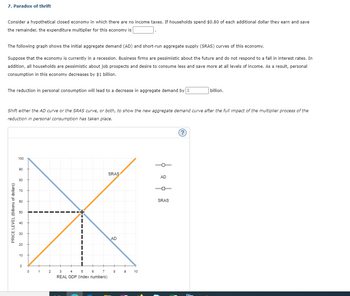
ENGR.ECONOMIC ANALYSIS
14th Edition
ISBN: 9780190931919
Author: NEWNAN
Publisher: Oxford University Press
expand_more
expand_more
format_list_bulleted
Question
Solve question no. 2 which is shaded.Hand written solutions are strictly prohibited

Transcribed Image Text:Since an economy's aggregate output measured by real GDP also represents the aggregate income received by the resources of production within the
economy, the decrease in aggregate demand you found equals the decrease in aggregate income. The effect of this decline in aggregate income is
billion.
in total saving of $
As personal consumption falls by $1 billion, the economy reaches a new equilibrium with an aggregate output of $
The total amount of saving
True or False: This is an example of the paradox of thrift.
O True
False
billion in the short run.
sol
this

Transcribed Image Text:7. Paradox of thrift
Consider a hypothetical closed economy in which there are no income taxes. If households spend $0.80 of each additional dollar they earn and save
the remainder, the expenditure multiplier for this economy is
The following graph shows the initial aggregate demand (AD) and short-run aggregate supply (SRAS) curves of this economy.
Suppose that the economy is currently in a recession. Business firms are pessimistic about the future and do not respond to a fall in interest rates. In
addition, all households are pessimistic about job prospects and desire to consume less and save more at all levels of income. As a result, personal
consumption in this economy decreases by $1 billion.
The reduction in personal consumption will lead to a decrease in aggregate demand by $
Shift either the AD curve or the SRAS curve, or both, to show the new aggregate demand curve after the full impact of the multiplier process of the
reduction in personal consumption has taken place.
PRICE LEVEL (Billions of dollars)
100
90
80
70
60
50
40
30
20
10
0
0
1
2
3
7
4 5 6
REAL GDP (Index numbers)
SRAS
AD
8
9
10
4 4
AD
SRAS
billion.
?
Expert Solution
This question has been solved!
Explore an expertly crafted, step-by-step solution for a thorough understanding of key concepts.
This is a popular solution
Trending nowThis is a popular solution!
Step by stepSolved in 4 steps with 4 images

Knowledge Booster
Learn more about
Need a deep-dive on the concept behind this application? Look no further. Learn more about this topic, economics and related others by exploring similar questions and additional content below.Similar questions
- (A) The biggest source of campaign funding today is: (a)public funding through the national government (b) PAC donations (c) individual donations (d) the two major political parties' direct funding of candidates (B) President Trump (a) Publicly conceeded defeat in the 2020 elections, but only after the gerogia electrol college was formally reviewed by an independent audit (b) was challenged in the primaries by a number of other republican candidates, but ultimately was renominated by the party for a 2nd term (c) refused to concede defeat after the 2020 elections (d) won the popular vote in 2020, but lost in the Electoral Collesearrow_forwardD.1.arrow_forwardNote:- Do not provide handwritten solution. Maintain accuracy and quality in your answer. Take care of plagiarism. Answer completely. You will get up vote for sure.arrow_forward
- What is this equation used for? What do the variables mean? Can you give an example how a research study can be applied to this formula? Does it account for control variables ?arrow_forwardIn terms of total number of businesses by form of ownership, corporations are more common than sole proprietorships. ( a) True ( b) Falsearrow_forwardPLS HELP ASAP ON BOTHarrow_forward
arrow_back_ios
arrow_forward_ios
Recommended textbooks for you

 Principles of Economics (12th Edition)EconomicsISBN:9780134078779Author:Karl E. Case, Ray C. Fair, Sharon E. OsterPublisher:PEARSON
Principles of Economics (12th Edition)EconomicsISBN:9780134078779Author:Karl E. Case, Ray C. Fair, Sharon E. OsterPublisher:PEARSON Engineering Economy (17th Edition)EconomicsISBN:9780134870069Author:William G. Sullivan, Elin M. Wicks, C. Patrick KoellingPublisher:PEARSON
Engineering Economy (17th Edition)EconomicsISBN:9780134870069Author:William G. Sullivan, Elin M. Wicks, C. Patrick KoellingPublisher:PEARSON Principles of Economics (MindTap Course List)EconomicsISBN:9781305585126Author:N. Gregory MankiwPublisher:Cengage Learning
Principles of Economics (MindTap Course List)EconomicsISBN:9781305585126Author:N. Gregory MankiwPublisher:Cengage Learning Managerial Economics: A Problem Solving ApproachEconomicsISBN:9781337106665Author:Luke M. Froeb, Brian T. McCann, Michael R. Ward, Mike ShorPublisher:Cengage Learning
Managerial Economics: A Problem Solving ApproachEconomicsISBN:9781337106665Author:Luke M. Froeb, Brian T. McCann, Michael R. Ward, Mike ShorPublisher:Cengage Learning Managerial Economics & Business Strategy (Mcgraw-...EconomicsISBN:9781259290619Author:Michael Baye, Jeff PrincePublisher:McGraw-Hill Education
Managerial Economics & Business Strategy (Mcgraw-...EconomicsISBN:9781259290619Author:Michael Baye, Jeff PrincePublisher:McGraw-Hill Education


Principles of Economics (12th Edition)
Economics
ISBN:9780134078779
Author:Karl E. Case, Ray C. Fair, Sharon E. Oster
Publisher:PEARSON

Engineering Economy (17th Edition)
Economics
ISBN:9780134870069
Author:William G. Sullivan, Elin M. Wicks, C. Patrick Koelling
Publisher:PEARSON

Principles of Economics (MindTap Course List)
Economics
ISBN:9781305585126
Author:N. Gregory Mankiw
Publisher:Cengage Learning

Managerial Economics: A Problem Solving Approach
Economics
ISBN:9781337106665
Author:Luke M. Froeb, Brian T. McCann, Michael R. Ward, Mike Shor
Publisher:Cengage Learning

Managerial Economics & Business Strategy (Mcgraw-...
Economics
ISBN:9781259290619
Author:Michael Baye, Jeff Prince
Publisher:McGraw-Hill Education